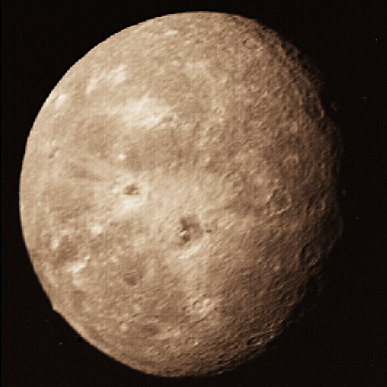Astronomy Picture of the Day
Discover the cosmos!
Each day a different image or photograph of our fascinating universe is
featured, along with a brief explanation written by a professional
astronomer.
April 8, 1996

Uranus's Moon Oberon: Impact World
Credit:
Photo Credit:
NASA, Voyager 2;
Courtesy Calvin J. Hamilton
Explanation:
Oberon is the most distant and second largest moon of Uranus. Discovered by
William Herschel
in 1787, the properties of the world remained relatively
unknown until the robot spacecraft
Voyager 2
passed it during its flyby of
Uranus in January 1986. Compared to Uranus'
moons
Ariel,
Titania, and
Miranda,
Oberon is heavily cratered, and in this
way resembles
Umbriel.
Like all of Uranus' large moons,
Oberon is composed
of roughly half ice and half rock. Note that Oberon has at least one
large mountain, visible on the limb at the lower left, that rises 6 km off
the surface.
Latest Comet Hyakutake images:
APOD Hyakutake Archive,
JPL,
Fayetteville
Observer-Times,
NASA's Night of
the Comet,
ICSTARS,
Jerry Lodriguss,
ScienceWeb,
Crni Vrh Obs.,
Cent. Mich. U.
Tomorrow's picture: A Spiral Galaxy Gallery
| Archive
| Index
| Search
| Glossary
| Education
| About APOD |




Authors & editors:
Robert Nemiroff
(GMU) &
Jerry
Bonnell (USRA).
NASA Technical Rep.:
Sherri
Calvo.
Specific rights apply.
A service of:
LHEA
at
NASA/
GSFC




